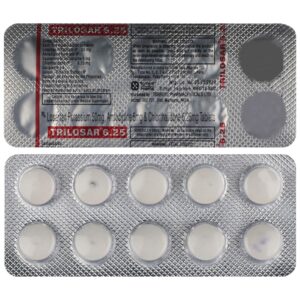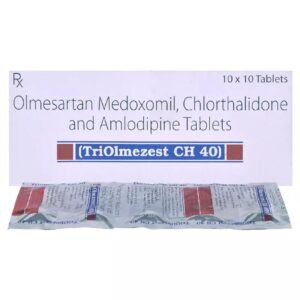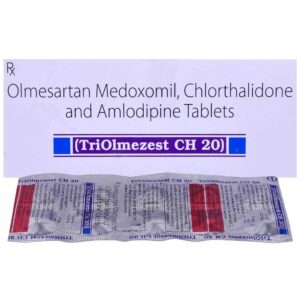AMLODIPINE + CHLORTHALIDONE + OLMESARTAN
Amlodipine: Amlodipine is a medication primarily used to treat high blood pressure (hypertension) and chest pain (angina). It belongs to a class of drugs called calcium channel blockers.
The main mechanism of action of amlodipine is the relaxation of blood vessels, which helps to lower blood pressure and improve blood flow. It does this by selectively blocking the entry of calcium ions into smooth muscle cells in blood vessel walls, resulting in the dilation of the blood vessels and reduced resistance to blood flow. Amlodipine also reduces the workload on the heart by decreasing the force of contraction.
The typical starting dose of amlodipine is 5mg once daily. However, the dosage may need to be adjusted based on individual response. The maximum daily dose is usually 10mg.
Like any medication, amlodipine can cause side effects. Common side effects include headache, dizziness, flushing, swelling of the ankles or feet, and tiredness. These are usually mild and transient. Less common but more serious side effects may include irregular heartbeat, fainting, severe dizziness, and swelling of the face, lips, tongue, or throat.
It is important to note that amlodipine may interact with other medications, so it is essential to inform your healthcare provider about any other drugs you are taking. This medication should be used with caution in patients with liver disease or heart failure.
In summary, amlodipine is a commonly prescribed medication for hypertension and angina. It works by relaxing blood vessels, thereby reducing blood pressure and improving blood flow. The typical dose is 5mg once daily, with possible adjustments depending on individual response. While generally well-tolerated, it may cause side effects such as headache, dizziness, and swelling.
Chlorthalidone: Chlorthalidone is a medication primarily used in the treatment of high blood pressure (hypertension) and fluid retention (edema) associated with heart failure. It belongs to a class of drugs called thiazide diuretics.
The mechanism of action of Chlorthalidone involves promoting the excretion of sodium and water by the kidneys, leading to decreased fluid volume in the body. This process helps to lower blood pressure by reducing the amount of fluid and pressure on the blood vessels.
The typical starting dose of Chlorthalidone for hypertension is 25 mg once daily, which may be increased to 50 mg if necessary. For edema associated with heart failure, the initial dose is usually 25-100 mg a day, depending on the individual’s condition and response.
Like all medications, Chlorthalidone may cause side effects. Common side effects include dizziness, lightheadedness, headache, and increased urination. It may also lead to low potassium levels (hypokalemia), which can cause muscle weakness, cramps, and irregular heartbeat. Rare but serious side effects include allergic reactions, liver disease, and kidney problems.
It is important to note that Chlorthalidone can interact with other medications, such as lithium, nonsteroidal anti-inflammatory drugs (NSAIDs), and certain diabetes medications. Therefore, it is crucial to consult a healthcare professional before starting or stopping any medication.
Overall, Chlorthalidone is an effective medication for managing high blood pressure and fluid retention, but it should only be used under the guidance of a healthcare professional due to the potential side effects and interactions with other medications.
Olmesartan: Olmesartan is a drug that belongs to the class of medications called angiotensin II receptor blockers (ARBs). It is primarily used in the management of high blood pressure (hypertension) in adults and children 6 years of age and older.
The main mechanism of action of Olmesartan is to block the binding of the hormone angiotensin II to its receptors, including the AT1 subtype receptor. By doing so, it helps to relax and widen blood vessels, reducing resistance and allowing blood to flow more easily. This ultimately leads to a decrease in blood pressure.
The typical starting dose of Olmesartan for adults is 20 mg once daily. Your doctor may adjust the dose based on your blood pressure response. The maximum recommended dose is 40 mg daily. For children 6 years of age and older, the dosage is based on body weight and ranges from 10 mg to 40 mg daily.
As with any medication, Olmesartan may cause side effects. The most common side effects include dizziness, back pain, diarrhea, and headache. Less commonly, it may cause allergic reactions, such as swelling of the face, lips, tongue, or throat, which require immediate medical attention. Other rare side effects may include muscle pain, decreased kidney function, and low blood pressure.
It’s important to note that Olmesartan may also have some rare but serious risks. In some cases, it can cause a severe intestinal condition called sprue-like enteropathy, which may lead to chronic diarrhea, weight loss, and malnutrition. If you experience these symptoms, you should contact your doctor right away.
Overall, Olmesartan is an effective medication for managing high blood pressure. However, it is important to follow your doctor’s instructions and report any side effects or concerns during treatment.




